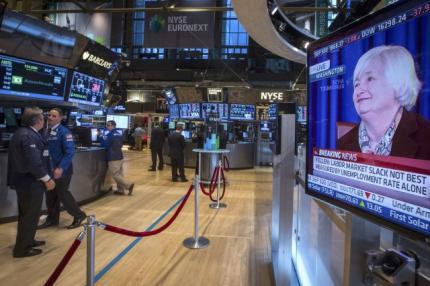Wall Street Sees Holes in Fed's New Policy-Tightening Plan
On Wednesday, the Fed surprised many by updating its policy "normalization" plan

On Wednesday, the Fed surprised many by updating its policy "normalization" plan
Bareksa.com - No sooner did the Federal Reserve reveal its plan for eventually tightening U.S. monetary policy than many on Wall Street flagged problems with the mechanics of the strategy, and said more adjustments would have to come.
Some market participants worried that a new limit on the Fed's reverse repurchase facility would hurt efforts to raise interest rates as quarters draw to an end when investors typically hunt for collateral. Others predicted the controversial tool would ultimately play a bigger role than the U.S. central bank let on.
In reverse repos, the Fed offers Treasury securities as collateral in exchange for cash from banks, large money market mutual funds and others, temporarily draining cash from the financial system.
Promo Terbaru di Bareksa
On Wednesday, the Fed surprised many by updating its policy "normalization" plan, meant to help the public understand exactly how it will raise rates from near zero when the time comes. The process will be unusually tricky given the tremendous amount of liquidity the central bank has pumped into financial markets to try to spur a stronger economic recovery.
The Fed also issued a policy statement at the close of a two-day meeting that suggested the first rate hike wasn't due until around the middle of next year.
According to the plan, the overnight repo facility, or RRP, would only be "supplementary," used "as needed" to serve as an effective floor under the main federal funds rate, and later shuttered.
At the same time, the Fed tripled the amount that each bank or fund could lend into the facility during its current testing and applied an overall $300-billion cap, less than the $340 billion in demand RRP faced at the quarter-end on June 30.
The new cap on what had been an unlimited facility raised fears that once the tightening cycle begins, and demand rises, financial markets could face unusual volatility on days that firms scramble for short-term collateral.
The Fed's policy-setting committee "will ultimately hold its nose and expand its RRP operations ... to a trillion dollars or more if that proves to be necessary to maintain a firm floor under rates," predicted Lou Crandall, chief economist at Wrightson ICAP LLC.
The central bank seems to be "downplaying the idea that the RRP facility might someday become the centerpiece of the Fed's operating procedures," he said.
The new limits are effective Sept. 22, and analysts said volatility could erupt eight days later when the quarter draws to a close. Some noted that the Fed aims to gather information on how participants will react on Sept. 30.
For a year, the central bank has been testing the facility as a way to control short-term rates by draining the trillions of dollars in reserves it has created fighting the deep recession. It has seen strong demand from bidders. But Fed policymakers grew concerned that over-reliance on repos could encourage runs on some funds deemed risky in times of market stress, and wanted to limit use of the facility.
"The new operating system has sacrificed control in favor of minimizing the Fed's presence in the repo market for fear a large presence may cause distortions," said William Lee, head of North America economics at Citigroup, adding the decision "may be a mistake."
The Fed, however, left itself much wiggle room. The new repo limits can be changed or dropped; no date was set for termination of the facility; and the central bank said it is "prepared to adjust the details" of its normalization plan based on economic or financial developments.
The Fed aims to use the repo rate as a floor when it raises the overnight federal funds rate to a higher target range, say between 0.25 and 0.50 percent. A rate the Fed pays banks on their excess reserves would serve as the ceiling and, according to the plan, be the primary tool to tighten policy.
Given the desire to limit use of repos, Fed Chair Janet Yellen acknowledged on Wednesday that the key fed funds rate "may vary within the target range and could even move outside of that range on occasion, but such movements should have no material effect on financial conditions or the broader economy."
Once demand at the facility exceeds $300 billion, an auction will determine the repo rate, not the central bank. In this case, investors would look beyond the Fed to other sources for funding, and the market-based rate would decline.
"In effect, this could mean a soggy or softer floor for the (fed funds) corridor," Millan Mulraine, deputy head of U.S. research at TD Securities, wrote in a client note.
"When the Fed goes live next year they are almost certainly expected to revert back to setting the price, and having the market determine the quantity of excess reserves drained," he wrote. "Otherwise it will work against the purpose of tightening."
Pilihan Investasi di Bareksa
Klik produk untuk lihat lebih detail.
| Produk Eksklusif | Harga/Unit | 1 Bulan | 6 Bulan | YTD | 1 Tahun | 3 Tahun | 5 Tahun |
|---|---|---|---|---|---|---|---|
Trimegah Dana Tetap Syariah Kelas A | 1.384,88 | ||||||
Trimegah Dana Obligasi Nusantara | 1.095,38 | - | |||||
STAR Stable Amanah Sukuk autodebet | 1.084,98 | - | - | ||||
Capital Fixed Income Fund autodebet | 1.853,59 | ||||||
Insight Renewable Energy Fund | 2.287,69 |

Produk Belum Tersedia
Ayo daftar Bareksa SBN sekarang untuk bertransaksi ketika periode pembelian dibuka.

Produk Belum Tersedia
Ayo daftar Bareksa SBN sekarang untuk bertransaksi ketika periode pembelian dibuka.